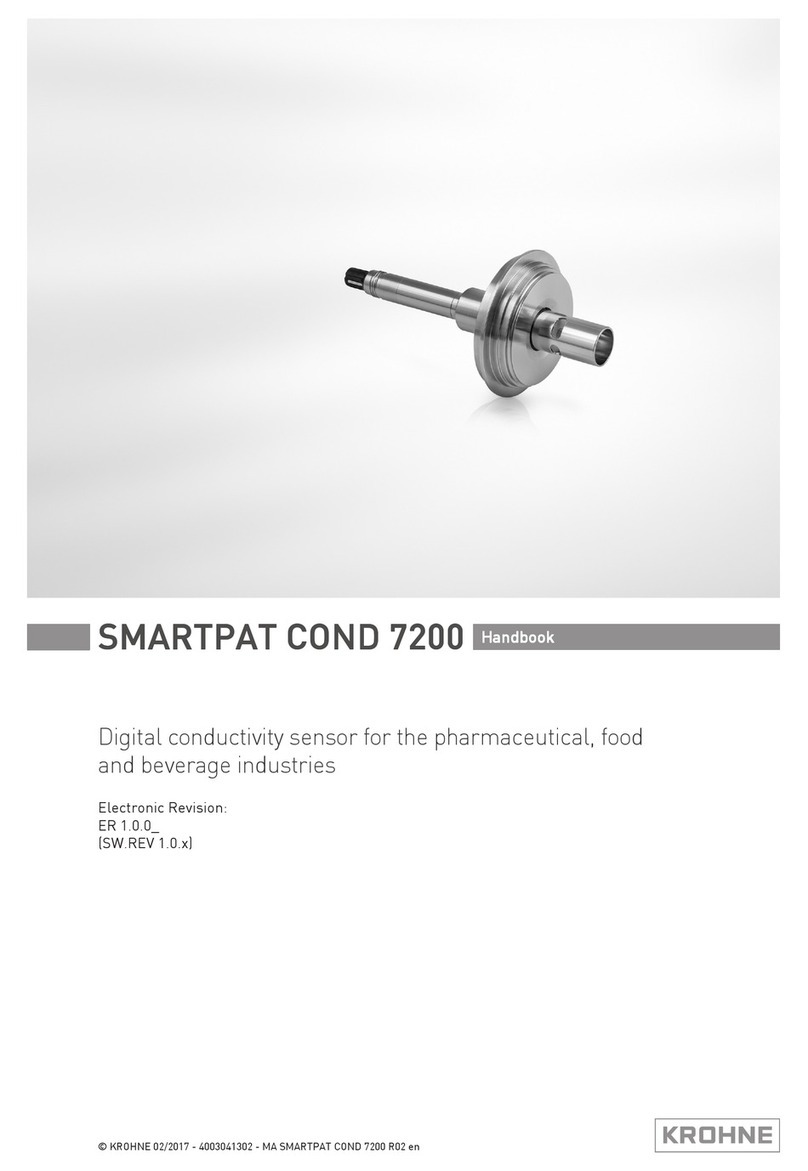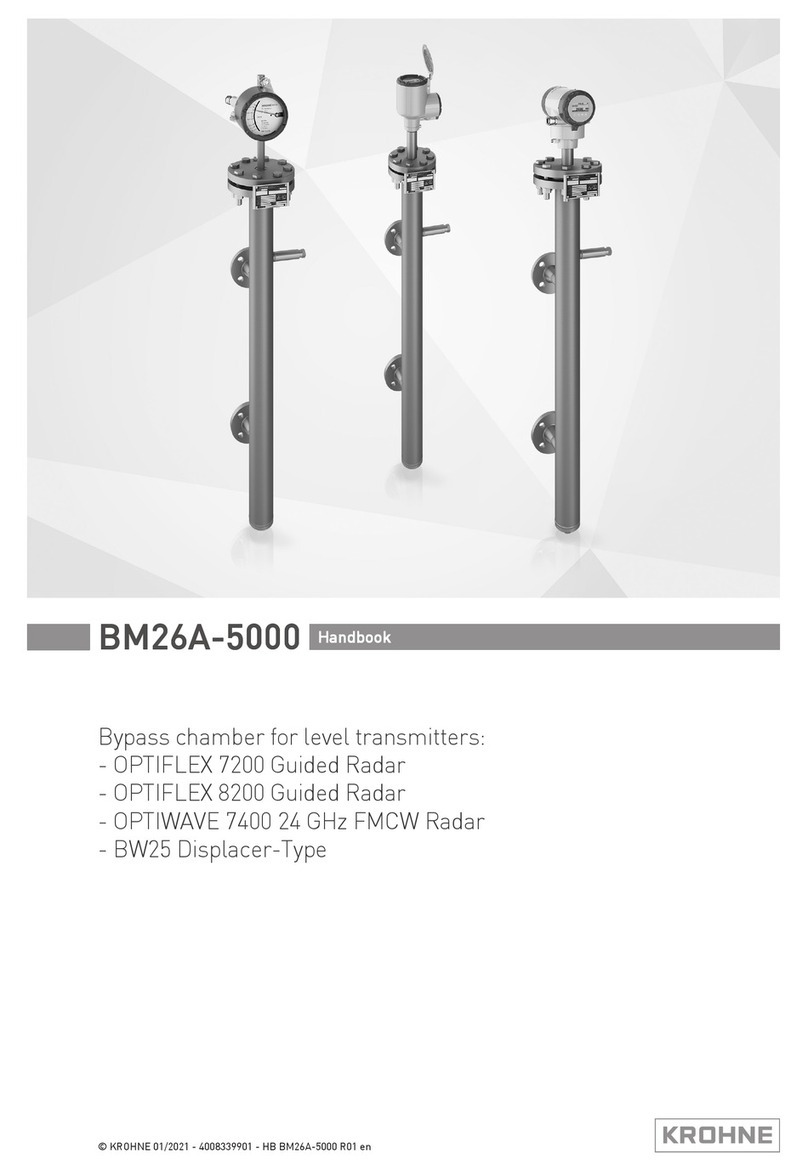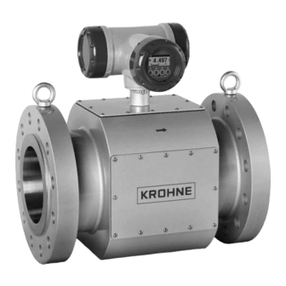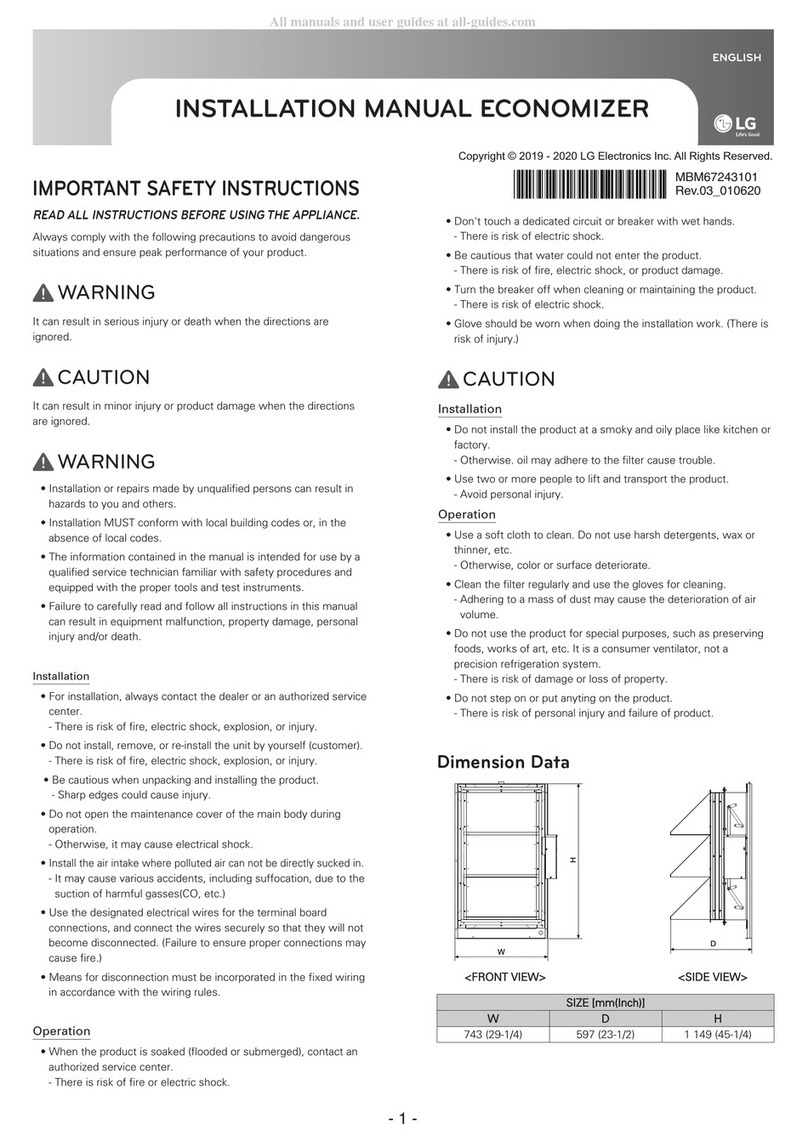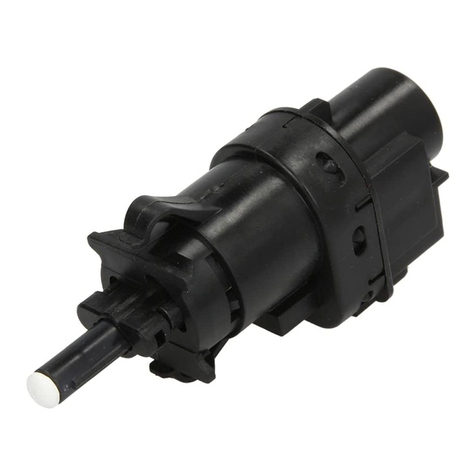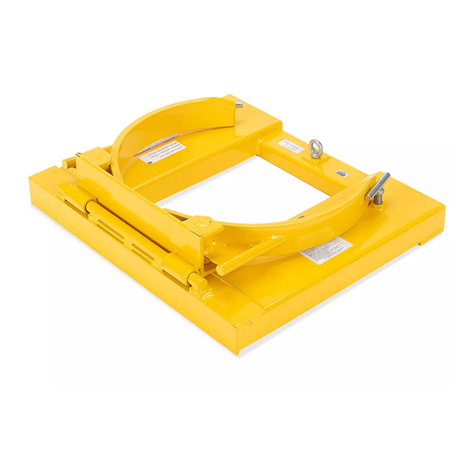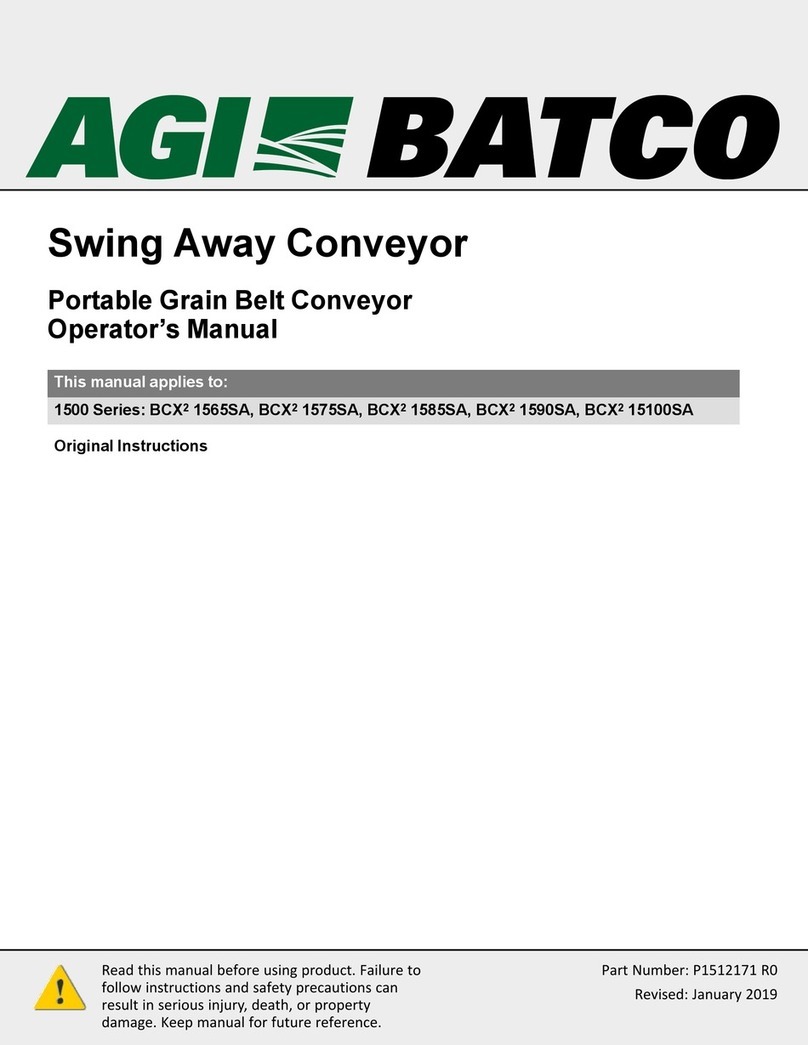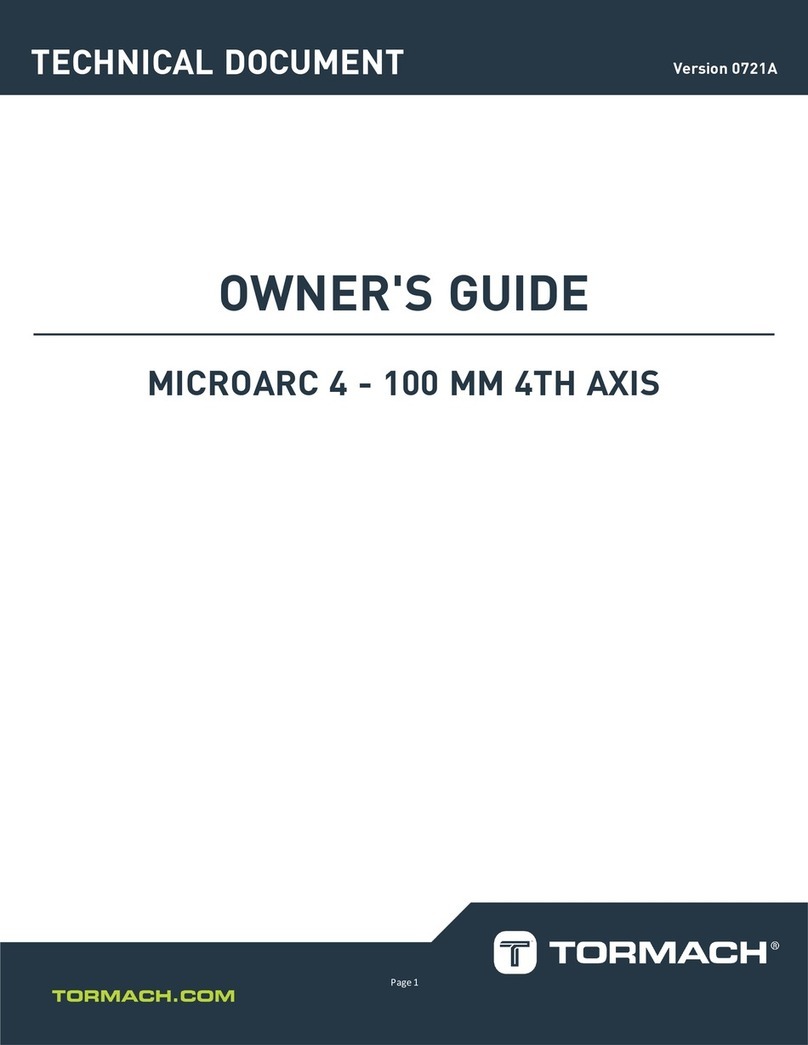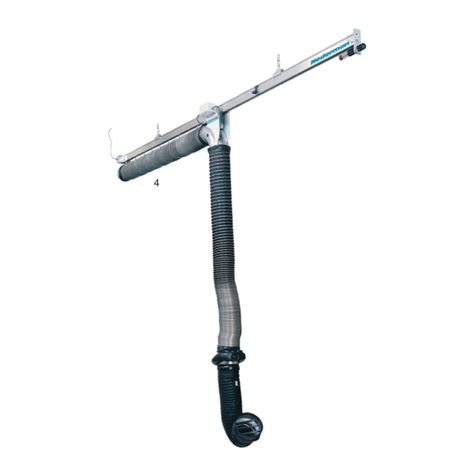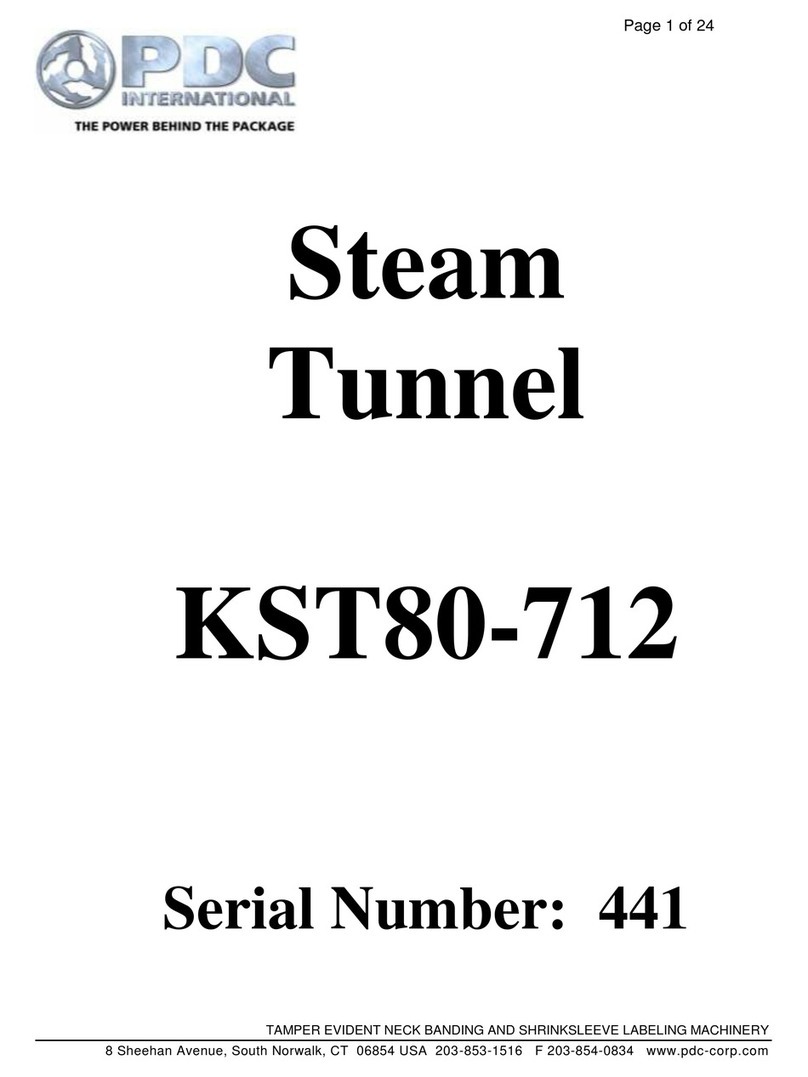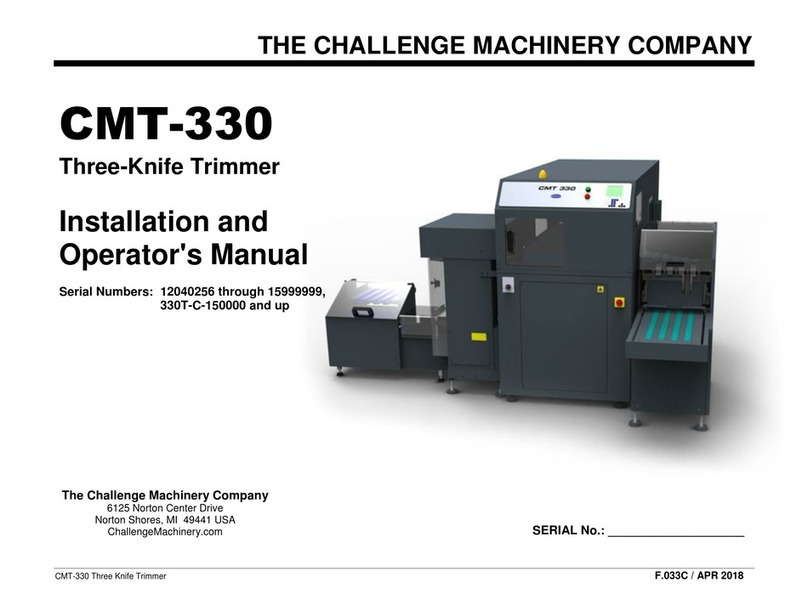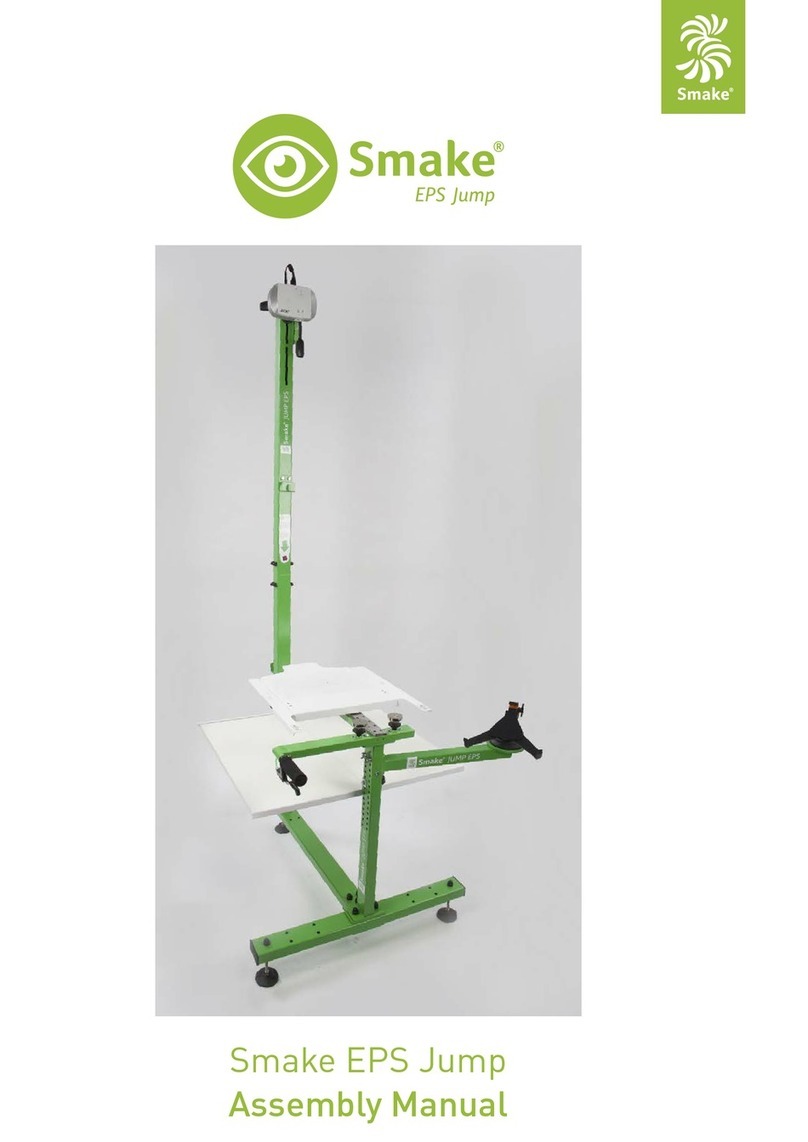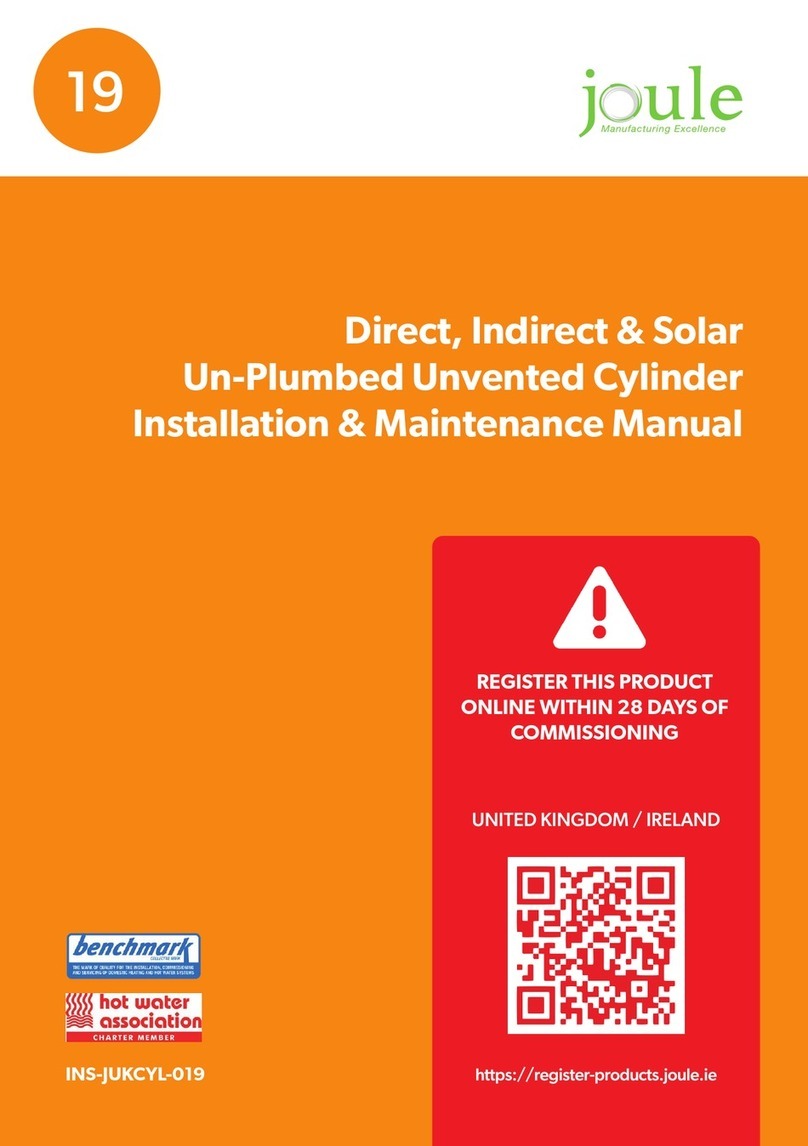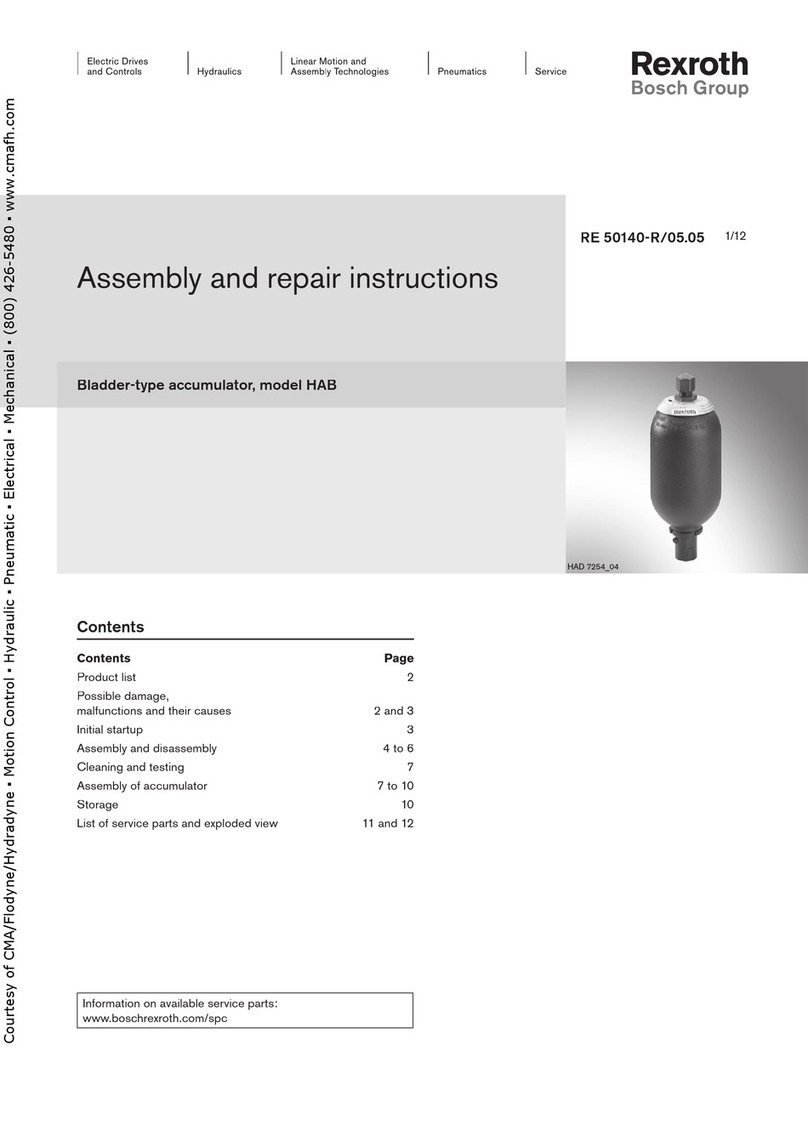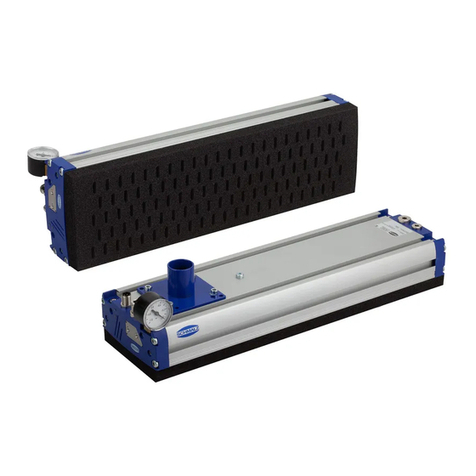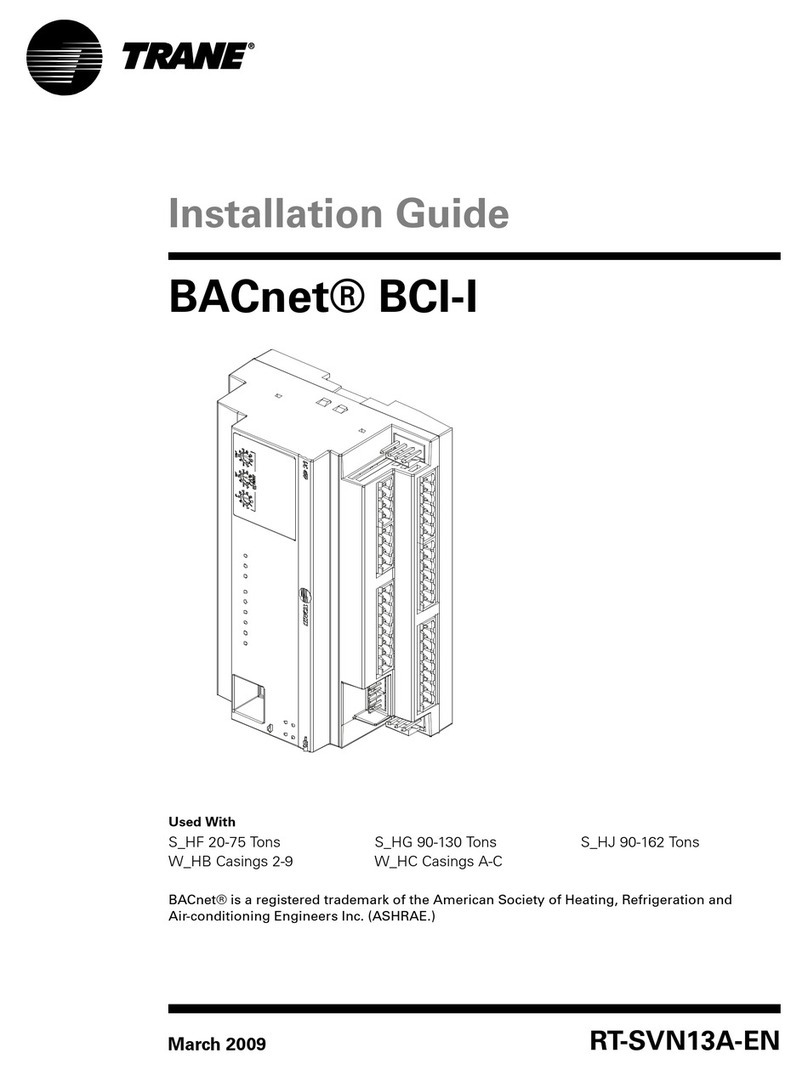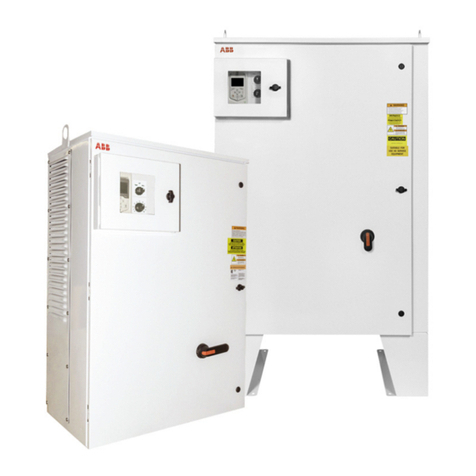KROHNE SU 501 Ex User manual

Operating Instructions
SU 501 Ex
Signal conditioning instrument
Document
ID: 27953

2
Contents
SU 501 Ex • Signal conditioning instrument
27953-EN-130627
Contents
1 About this document
1.1 Function ........................................................................................................................... 3
1.2 Target group ..................................................................................................................... 3
1.3 Symbolism used............................................................................................................... 3
2 For your safety
2.1 Authorised personnel ....................................................................................................... 4
2.2 Appropriate use................................................................................................................ 4
2.3 Warning about incorrect use............................................................................................. 4
2.4 General safety instructions............................................................................................... 4
2.5 Safety label on the instrument .......................................................................................... 4
2.6 CE conformity................................................................................................................... 5
2.7 Safety instructions for Ex areas ........................................................................................ 5
3 Product description
3.1 Conguration.................................................................................................................... 6
3.2 Principle of operation........................................................................................................ 6
3.3 Adjustment ....................................................................................................................... 7
3.4 Packaging, transport and storage..................................................................................... 7
4 Mounting
4.1 General instructions ......................................................................................................... 8
4.2 Mounting instructions ....................................................................................................... 8
5 Connecting to power supply
5.1 Preparing the connection ............................................................................................... 11
5.2 Connection procedure.................................................................................................... 11
5.3 Wiring plan ..................................................................................................................... 12
6 Setup
6.1 Adjustment system......................................................................................................... 13
6.2 Adjustment elements...................................................................................................... 14
6.3 Function chart ................................................................................................................ 17
7 Maintenanceandfaultrectication
7.1 Maintenance .................................................................................................................. 19
7.2 Rectify faults................................................................................................................... 19
7.3 Instrument repair ............................................................................................................ 21
8 Dismounting
8.1 Dismounting steps.......................................................................................................... 23
8.2 Disposal ......................................................................................................................... 23
9 Supplement
9.1 Technical data ................................................................................................................ 24
9.2 Dimensions .................................................................................................................... 26
Editing status: 2012-05-10

3
1 About this document
SU 501 Ex • Signal conditioning instrument
27953-EN-130627
1 About this document
1.1 Function
This operating instructions manual provides all the information you
need for mounting, connection and setup as well as important instruc-
tionsformaintenanceandfaultrectication.Pleasereadthisinforma-
tion before putting the instrument into operation and keep this manual
accessible in the immediate vicinity of the device.
1.2 Target group
This operating instructions manual is directed to trained specialist
personnel. The contents of this manual should be made available to
these personnel and put into practice by them.
1.3 Symbolism used
Information, tip, note
This symbol indicates helpful additional information.
Caution: If this warning is ignored, faults or malfunctions can result.
Warning: If this warning is ignored, injury to persons and/or serious
damage to the instrument can result.
Danger: If this warning is ignored, serious injury to persons and/or
destruction of the instrument can result.
Ex applications
This symbol indicates special instructions for Ex applications.
•List
The dot set in front indicates a list with no implied sequence.
→ Action
This arrow indicates a single action.
1 Sequence of actions
Numbers set in front indicate successive steps in a procedure.
Battery disposal
This symbol indicates special information about the disposal of bat-
teries and accumulators.

4
2 For your safety
SU 501 Ex • Signal conditioning instrument
27953-EN-130627
2 For your safety
2.1 Authorised personnel
All operations described in this operating instructions manual must
be carried out only by trained specialist personnel authorised by the
plant operator.
During work on and with the device the required personal protective
equipment must always be worn.
2.2 Appropriate use
SU 501 Ex is a universal signal conditioning instrument for connection
of a level switch.
Yo u cannddetailedinformationontheapplicationrangeinchapter
"Product description".
Operational reliability is ensured only if the instrument is properly
usedaccordingtothespecicationsintheoperatinginstructions
manual as well as possible supplementary instructions.
For safety and warranty reasons, any invasive work on the device
beyond that described in the operating instructions manual may be
carried out only by personnel authorised by the manufacturer. Arbi-
traryconversionsormodicationsareexplicitlyforbidden.
2.3 Warning about incorrect use
Inappropriate or incorrect use of the instrument can give rise to
application-specichazards,e.g.vesseloverllordamagetosystem
components through incorrect mounting or adjustment.
2.4 General safety instructions
This is a high-tech instrument requiring the strict observance of stand-
ard regulations and guidelines. The user must take note of the safety
instructionsinthisoperatinginstructionsmanual,thecountry-specic
installation standards as well as all prevailing safety regulations and
accident prevention rules.
Theinstrumentmustonlybeoperatedinatechnicallyawlessand
reliable condition. The operator is responsible for trouble-free opera-
tion of the instrument.
During the entire duration of use, the user is obliged to determine the
compliance of the necessary occupational safety measures with the
current valid rules and regulations and also take note of new regula-
tions.
2.5 Safety label on the instrument
The safety approval markings and safety tips on the device must be
observed.

5
2 For your safety
SU 501 Ex • Signal conditioning instrument
27953-EN-130627
2.6 CE conformity
ThisdevicefulllsthelegalrequirementsoftheapplicableECguide-
lines.ByattachingtheCEmark,weprovideconrmationofsuccess-
ful testing.
2.7 Safety instructions for Ex areas
PleasenotetheEx-specicsafetyinformationforinstallationandop-
eration in Ex areas. These safety instructions are part of the operating
instructions manual and come with the Ex-approved instruments.

6
3 Product description
SU 501 Ex • Signal conditioning instrument
27953-EN-130627
3 Product description
3.1 Conguration
The scope of delivery encompasses:
•SU 501 Ex signal conditioning instrument
•Terminal socket
•Bridges (4 pieces)
•Coded pins (2 pieces)
•Ex label
•Ex separating chamber
•Documentation
– this operating instructions manual
– Ex-specic"Safety instructions" (with Ex versions)
– ifnecessary,furthercerticates
The SU 501 Ex consists of:
•SU 501 Ex signal conditioning instrument
56 78
910121314
TEST
on
3
1
2
Fig. 1: SU 501 Ex
1 Ex separating chamber with Ex version
2 Terminal socket
3 Transparent cover
Thenameplatecontainsthemostimportantdataforidenticationand
use of the instrument:
•Article number
•Serial number
•Technical data
•Article numbers, documentation
3.2 Principle of operation
SU 501 Ex is a single signal conditioning instrument for processing of
vibrating level switches.
Scope of delivery
Constituent parts
Type plate
Application area

7
3 Product description
SU 501 Ex • Signal conditioning instrument
27953-EN-130627
The SU 501 Ex signal conditioning instrument powers connected sen-
sors and simultaneously processes their measuring signals.
When the medium reaches the switching point of the sensor, the volt-
age on the sensor drops. The output relays then switch according to
the set mode.
Wide-range power supply unit with 20 … 253 V AC/DC for world-wide
use.
Detailed information about the power supply can be found in chapter
"Technical data".
3.3 Adjustment
The switching delay and the mode (A/B) can be preset on the signal
conditioning instrument via a DIL switch block.
A test key is lowered on the front plate of SU 501 Ex. When pushing
the key, the measuring system is checked on correct function.
3.4 Packaging, transport and storage
Your instrument was protected by packaging during transport. Its
capacity to handle normal loads during transport is assured by a test
based on ISO 4180.
The packaging of standard instruments consists of environment-
friendly, recyclable cardboard. For special versions, PE foam or PE
foil is also used. Dispose of the packaging material via specialised
recycling companies.
Transport must be carried out under consideration of the notes on the
transport packaging. Nonobservance of these instructions can cause
damage to the device.
The delivery must be checked for completeness and possible transit
damage immediately at receipt. Ascertained transit damage or con-
cealed defects must be appropriately dealt with.
Up to the time of installation, the packages must be left closed and
stored according to the orientation and storage markings on the
outside.
Unless otherwise indicated, the packages must be stored only under
the following conditions:
•Not in the open
•Dry and dust free
•Not exposed to corrosive media
•Protected against solar radiation
•Avoiding mechanical shock and vibration
•Storage and transport temperature see chapter "Supplement -
Technical data - Ambient conditions"
•Relative humidity 20 … 85 %
Functional principle
Voltage supply
Packaging
Transport
Transport inspection
Storage
Storage and transport
temperature

8
4 Mounting
SU 501 Ex • Signal conditioning instrument
27953-EN-130627
4 Mounting
4.1 General instructions
SU 501 Ex signal conditioning instrument with plug-in socket for
mounting on carrier rail according to EN 50022.
The front plate of SU 501 Ex can be provided with a lead-sealable
transparent cover to protect the instrument against unauthorised or
inadvertentadjustment.Seethefollowinggureonhowtoremovethe
transparent cover.
Fig. 2: Removing the transparent cover
For moisture-protected mounting outside the switching cabinet, we
oeraninsulatedprotectivehousingwithtransparentcover(IP65)for
surface mounting.
In this housing you can mount a maximum of 3 instruments of 36 mm
width.
4.2 Mounting instructions
The plug-in socket is constructed for carrier rail mounting according
to EN 50022. Operating voltage is connected to terminals 9 and 10.
For neighbouring signal conditioning instruments, it is possible to
continue connection L1 and N directly via the supplied bridges.
Danger:
The bridges must never be used with single instruments or at the end
of a row of instruments. If this rule is not heeded, there is a danger
of coming into contact with the operating voltage or causing a short
circuit.
A SU 501 Ex in Ex version is an auxiliary, intrinsically safe instrument
and may not be installed in explosion-endangered areas.
Installation place
Transparent cover
Housing IP 65
Installation

9
4 Mounting
SU 501 Ex • Signal conditioning instrument
27953-EN-130627
Before setup, the Ex separating chamber must be attached (as shown
below) with Ex versions. Safe operation can be only ensured if the
operatinginstructionsmanualandtheEGtypeapprovalcerticate
are observed. SU 501 Ex must not be opened.
Close the upper terminals according to the following illustration.
12 43
Fig. 3: Mounting the separating chamber
Allsignalconditioninginstrumentsareprovidedwithdierentgaps
dependent on type and version (mechanical coding).
The plug-in socket is provided with coded pins that can be inserted to
prevent accidental interchanging of the various instrument types.
With a SU 501 Ex in Ex version, the supplied coded pins (type coded
pin and Ex coded pin) must be inserted by the user according to the
below chart.
Ex separating chamber
Instrument coding

10
4 Mounting
SU 501 Ex • Signal conditioning instrument
27953-EN-130627
Typ 600-1
56 78
141312109
4321
EEx ia
+
-
L1
N
DISBUS
0...10V
9
8
7
3
2
1
C
B
A
12
Plug-in socket
2
1
3
4
Fig. 4: Plug-in socket SU 501 Ex
1 Bridges for looping the operating voltage
2 Type coding for SU 501 Ex
3 Ex coding with Ex version
4 Ex separating chamber

11
5 Connecting to power supply
SU 501 Ex • Signal conditioning instrument
27953-EN-130627
5 Connecting to power supply
5.1 Preparing the connection
Always keep in mind the following safety instructions:
•Connect only in the complete absence of line voltage
•If overvoltage surges are expected, overvoltage arresters should
be installed.
Inhazardousareasyoumusttakenoteoftherespectiveregulations,
conformityandtypeapprovalcerticatesofthesensorsandpower
supply units.
Thepowersupplycanbe20…250VAC,50/60Hzor20…72VDC.
The operating voltage of SU 501 Ex is connected with standard cable
according to the national installation standards.
The sensors are connected with standard two-wire cable without
screen. If electromagnetic interference is expected which is above the
test values of EN 61326 for industrial areas, screened cable should
be used.
Use cable with round cross-section. A cable outer diameter of
5…9mm(0.2…0.35in)ensuresthesealeectofthecablegland.
Ifyouareusingcablewithadierentdiameterorcross-section,
exchange the seal or use a suitable cable gland.
Connect the cable screen on both ends to ground potential. In the
sensor, the screen must be connected directly to the internal ground
terminal. The ground terminal on the outside of the sensor housing
must be connected to the potential equalisation (low impedance).
If potential equalisation currents are expected, the screen connec-
tion on SU 501 Ex must be made via a ceramic capacitor (e. g. 1 nF,
1500 V). The low frequency potential equalisation currents are thus
suppressed,buttheprotectiveeectagainsthighfrequencyinterfer-
ence signals remains.
Take note of the corresponding installation regulations for Ex applica-
tions. In particular, make sure that no potential equalisation currents
owoverthecablescreen.Incaseofgroundingonbothsidesthis
can be achieved by the use of a capacitor or a separate potential
equalisation.
5.2 Connection procedure
Move on to electrical connection and proceed as follows:
1. Snap the socket without SU 501 Ex onto the carrier rail
2. Connect sensor cable to terminal 1 and 2, and where applicable,
connect the screen
3. Connectpowersupply(switchedo)toterminal9and10
4. Insert SU 501 Ex into the plug-in socket and screw it down tightly
Theelectricalconnectionishencenished.
Note safety instructions
Take note of safety
instructions for Ex
applications
Voltage supply
Connection cable
Cable screening and
grounding
Connection cable
for Ex applications

12
5 Connecting to power supply
SU 501 Ex • Signal conditioning instrument
27953-EN-130627
Before setting up Ex versions, make sure the Ex separating chamber
is plugged (above the sensor terminals). The pins for type and Ex
coding must also be inserted correctly.
5.3 Wiring plan
3
5 4
1
2
56 78
12 34
910121314
+-
+
L1 N
-
Fig. 5: Wiring plan SU 501 Ex
1 Sensor
2 Sensor input
3 Transistor output
4 Relay output
5 Operating voltage

13
6 Setup
SU 501 Ex • Signal conditioning instrument
27953-EN-130627
6 Setup
6.1 Adjustment system
Typ 600-1
on
56 78
910121314
56 78
141312109
4321
TEST
EEx ia
+
-
L1
N
DISBUS
0...10V
9
8
7
3
2
1
C
B
A
12
Plug-in socket
6
5
10
7
7
8
9
1
2
3
4
Fig. 6: Display and adjustment elements
1 Test key
2 Control lamp - level relay (LED yellow)
3 Control lamp - Fault signal (LED red)
4 Control lamp - Operating voltage (LED green)
5 Ex separating chamber
6 Terminal for probe
7 Sockets for bridges
8 Transistor output
9 Relay output
10 Voltage supply

14
6 Setup
SU 501 Ex • Signal conditioning instrument
27953-EN-130627
123456
12
6
2
ze
za
AB
off
t sec
IP 30
Sensorstromkreis EEx ia IIC
60mA
-
+
-
+
PTB-Nr.: Ex-95/xxxx X
max: 36V
56
nsp.I
a: -20...+60°C
power supply
20...72VDC
2 W
20...250 VAC
LN
Sensor
12
Terminal
1312
out
14
3AAC/1ADC
500VA/54W
max.250VAC/DC
910
+-
Uo< xx VL
o< xx mH
Co < xx nF
Po< xx mW
Io< xx mA
1
23
Fig. 7: Display and adjustment elements
1 DIL switch block
2 Type plate
3 Transparent cover
6.2 Adjustment elements
Control lamps (LED) in the front plate indicate operation, switching
status and fault signal.
•Green
– Operating control lamp
– Mains voltage on, instrument is operating
•Red
– Failure lamp
– Fault on the sensor circuit due to sensor failure or line break
– The relay deenergises in case of failure
•Yellow
Control lamps

15
6 Setup
SU 501 Ex • Signal conditioning instrument
27953-EN-130627
– Relay control lamp
– The yellow relay control lamp reacts depending on the set
mode (A/B)
– The relay control lamp generally indicates the activated (ener-
gized)conditionoftherelay
– A dark relay control lamp means that the relay is deenergised
(transistor blocks)
Laterally on top (covered when mounted) there is a DIL switch block
with six switches. The individual switches are assigned as follows:
•1 - A/B mode
– A-Max.detectionoroverowprotection
– B - Min. detection or dry run detection
•2-Switchodelay(za)
•3-Switchondelay(ze)
•4 - Switching delay 2 s
•5 - Switching delay 6 s
•6 - Switching delay 12 s
Withswitch1youcanadjustthemode(A-overllprotectionorB-
dry run protection).
Withswitches2and3youcansetswitchoand/orswitchondelays
independent of each other.
The delay refers to the switching function of the relay.
In the example (see previous illustration), mode A (max. detection of
overllprotection)isselected(switch1).Theswitchodelayisacti-
vated (switch 2) and the switching delay is set to 8 seconds (switch 4,
5 and 6).
With switches 4, 5 and 6 you can adjust the switching delay. The times
oftheactivatedtimeswitchesaccumulate.Iftheswitchon(ze)and
switchodelay(za)areswitchedontogether,thesettimeappliesto
both delay modes.
Hence the relay deenergises with 8 seconds delay time when the
switching point is reached.
Information:
Keep in mind that the switching delay of the sensor and signal condi-
tioning instrument accumulate.
Switch 123456
Time za ze 2 s 6 s 12 s
0.2 s A/B o o o o o
0.5 s A/B 1) o o o
2 s A/B on o o
6 s A/B o on o
8 s A/B on on o
12 s A/B o o on
DIL switch block
1) Set alternately switch 2 and/or 3 to "on". The times apply to the adjusted
delay mode.

16
6 Setup
SU 501 Ex • Signal conditioning instrument
27953-EN-130627
Switch 123456
14 s A/B on o on
18 s A/B o on on
20 s A/B on on on
The measuring system is continuously monitored. The following
criteria are checked:
•Two-wire cable on line break and shortcircuit
•Interruptionoftheconnectioncabletothepiezoelements
•Corrosion or damage of the tuning fork (vibrating rod)
•Break of the tuning fork (vibrating rod)
•Loss of vibration
•Too low vibrating frequency
•Medium penetrating from the vessel side into the sensor
In systems with OPTISWITCH level switches in conjunction with a
two-wire electronics module, a function test can be carried out. SU
501 Ex has an integrated test key. The test key is lowered in the front
plate of the signal conditioning instrument. Push the test key with a
suitable object (e.g. screwdriver, pen etc.).
By pushing the key, the system is checked on the following criteria:
•Switching function of the switching outputs
•Potential separation of the outputs
•The signal processing of the signal conditioning instrument
After pushing the test key, the complete measuring system is checked
on correct function. The following operating conditions are simulated
during the test:
•Fault message
•Empty signal
•Full signal
Check if all three switching conditions occur in the correct sequence
and the stated duration. If not, there is a fault in the measuring system
(see chapter "Fault rectication").
Note:
Keep in mind that the connected instruments are activated during the
function test. By doing this, you can check the correct function of the
measuring system.
After releasing the key.
Thespeciedtimesapplywithatoleranceof±20%.
A-mode B-mode
1 Simulation of a fault signal (approx. 3 s)
Level relay deenergised Relay control
lampo
Relay control
lampo
Function monitoring
Test key
Test procedure

17
6 Setup
SU 501 Ex • Signal conditioning instrument
27953-EN-130627
A-mode B-mode
1 Simulation of a fault signal
Failure lamp Failure lamp
lights
Failure lamp
lights
2 Simulation an empty signal (approx. 1.5 s)
Level relay energised Relay control
lamp lights
Relay control
lampo
2 Simulation of an empty signal
Failure lamp Failurelampo Failurelampo
3 Simulation of a full signal (approx. 1.5 s)
Level relay deenergised Relay control
lampo
Relay control
lamp lights
3 Simulation of a full signal
Failure lamp Failurelampo Failurelampo
4 Return to the current operating condition (covered/uncovered)
Check the procedure of the function test. Note the following criteria for
assessment of the result:
Test passed
If all three switching conditions occur in the correct sequence and the
speciedduration(±20%),thenthetestispassedandtheinstrument
functions correctly.
Test not passed
•Thespeciedtimesdeviateconsiderablyfromthetable(>3s)
•One of the switching conditions remains unchanged
•No start-up of the test - no signal sequence
6.3 Function chart
The following chart provides an overview of the switching conditions
depending on the set mode and the level.
The mode switch on the sensor (if available) must be set to max.
operation.
Sensor (max. opera-
tion)
Signal conditioning instrument
Mode on
the signal
condi-
tioning
instrument
Level Signal
current -
Sensor
Sig-
nal lamp
- Switch-
ing output
(yellow)
Con-
trol lamp
- Failure
(red)
Outputs
Mode A
Overow
protection
approx.
8 mA
Relay ener-
gized
transistor
conducts
Evaluation

18
6 Setup
SU 501 Ex • Signal conditioning instrument
27953-EN-130627
Sensor (max. opera-
tion)
Signal conditioning instrument
Mode on
the signal
condi-
tioning
instrument
Level Signal
current -
Sensor
Sig-
nal lamp
- Switch-
ing output
(yellow)
Con-
trol lamp
- Failure
(red)
Outputs
Mode A
Overow
protection
approx.
16 mA
Relay de-
energized
transistor
blocks
Mode B
Dry run
protection
approx.
16 mA
Relay ener-
gized
transistor
conducts
Mode B
Dry run
protection
approx.
8 mA
Relay de-
energized
transistor
blocks
Fault mes-
sage
(mode A/B)
any approx.
1.8 mA
Relay de-
energized
transistor
blocks

19
7Maintenanceandfaultrectication
SU 501 Ex • Signal conditioning instrument
27953-EN-130627
7 Maintenanceandfaultrectication
7.1 Maintenance
If the instrument is used properly, no special maintenance is required
in normal operation.
7.2 Rectify faults
The operator of the system is responsible for taking suitable meas-
ures to rectify faults.
A maximum of reliability is ensured. Nevertheless, faults can occur
during operation. These may be caused by the following, e.g.:
•Measured value from sensor not correct
•Voltage supply
•Interference on the cables
Therstmeasuretobetakenistochecktheinputandoutputsignals.
The procedure is described as follows. In many cases the causes can
bedeterminedthiswayandfaultscanbeeasilyrectied.
Error code Cause Rectication
The red fail-
ure control
lamp (LED)
of the signal
conditioning
instrument
lights
Sensor not connect-
ed correctly
– Measure the current value on the
signal cable to the sensor
– In Ex systems, make sure that the Ex
protectionisnotinuencedbythe
measuring instruments used.
– Faults on the sensor causing a cur-
rent change below 2.3 mA or above
23.2 mA, cause a fault signal on
measuring instruments.
+
-
VmA
12... 20V4... 20mA
1
2
12 34
Fig. 22: Connection of a multimeter
1 SU 501 Ex signal conditioning
instrument
2 Sensor
Sensor not connect-
ed correctly
– Measure the voltage on the connec-
tion cable
– In Ex systems, make sure that the Ex
protectionisnotinuencedbythe
measuring instruments used.
– The terminal voltage of the sensor is
at least 12 V in normal condition
Reaction when malfunc-
tions occur
Failure reasons
Faultrectication
Fault

20
7Maintenanceandfaultrectication
SU 501 Ex • Signal conditioning instrument
27953-EN-130627
Error code Cause Rectication
The red fail-
ure control
lamp (LED)
of the signal
conditioning
instrument
lights
Current value
< 2.3 mA
– Measure the current value on the
signal cable to the sensor
1. Check all connections and
connection cables to the sen-
sor
The voltage should be approx.
17 … 20 V
If the value is below 17 V, prob-
ably the signal conditioning
instrument is defective.
Exchange the signal condition-
ing instrument or send it for
repair
2. If the red failure lamp contin-
ues to light, separate the sen-
sor from the connection cable
andconnectaresistorof1kΩ
instead on the signal condition-
ing instrument
If the failure lamp continues to
light, the signal conditioning
instrument is defective
Exchange the signal condition-
ing instrument or send it for
repair
3. Should the failure lamp
extinguish, you can connect
the sensor again. Separate the
signal conditioning instrument
from the connection cable and
connectaresistorof1kΩto
the sensor input
4. If the failure lamp continues to
light, the connection cable is
probably interrupted
Check the connection cable to
the sensor
5. Should the failure lamp
extinguish, the sensor will be
defective
Exchange the sensor or send it
in for repair
Other manuals for SU 501 Ex
2
Table of contents
Other KROHNE Industrial Equipment manuals
